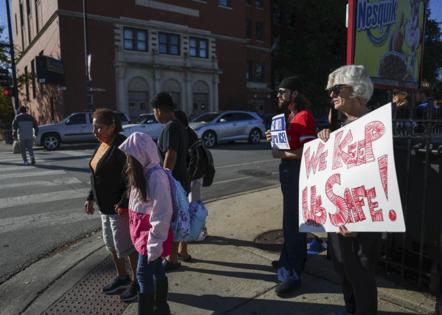ICE fears ripple across Chicago Public Schools, suburban districts
Published in News & Features
Monica Perez scanned the street as she left Funston Elementary, five of her children in tow. She kept her head down, her family close. After school pickup was once a familiar routine — in recent weeks, though, fear had crept into the family’s life and festered.
“Rápido,” Perez told her children, ushering them along Logan Square sidewalks. “Quickly.”
Perez came to Chicago from Mexico in 2007 without authorization. All seven of her children, ages 7 to 16, were born in the U.S. But as federal immigration enforcement intensifies across the city, even the short walk from school feels dangerous.
Perez mentally mapped their route, again and again: one block west, a few blocks north. They moved fast. Just the day before, she had kept her younger children home after hearing reports of U.S. Immigration and Customs Enforcement activity near campus.
“Ahorita, ando con miedo, pero los tuve que traer,” Perez, 36, said in Spanish. “I’m scared right now, but I had to bring them.”
Across Chicago Public Schools and surrounding districts, the Trump administration’s immigration crackdown has left families on edge — including the city’s youngest residents. School staff have scrambled to offer support in the classroom, while volunteers have organized ICE watch groups and student escorts for safe arrival and dismissal.
In response, CPS is expanding its 24-hour Student Safety Center with a dedicated team to triage incidents related to federal law enforcement. The center allows school leaders to report incidents and receive real-time guidance, the district said in a statement.
Schools have also been directed to establish ICE protocols and hold staff trainings, CPS interim Superintendent Macquline King told the Chicago Board of Education Wednesday.
“We understand the weight many of our families are carrying,” King said.
Since the launch of “Operation Midway Blitz” in September, federal agents have made more than 800 arrests in the Chicago area, according to the most recent count from the U.S. Department of Homeland Security. The Trump administration has vowed to target “the worst of the worst,” but many of those detained have no criminal record.
Chicago-area schools have been swept up in the chaos. Several have gone into lockdown and canceled field trips or homecoming events in response to nearby ICE activity. Some parents say they fear being targeted during drop-off or pickup; others are keeping their children home as a precaution. Schools have reported a growing number of students now walking to class alone.
Standing watch
Earlier this month, recess at Funston Elementary was held indoors, after masked federal agents deployed tear gas just across the street. The agents had thrown the smoke canisters when bystanders blocked their vehicle. In the days that followed, scores of volunteers began surrounding the school during dismissal, mobilized through rapid response networks and social media.
On a recent afternoon, Evelyn Medina, 43, stood on a sidewalk handing out neon whistles, flyers and “ICE Out!” signs. Medina owns a gift shop directly next to the school. The tear gas had drifted into her boutique during the recent incident — but her main concern was for the students. Since then, she’s purchased hundreds of whistles for community members.
“I was afraid for the children,” Medina said, watching families walk by. “I think at this point, we have to do what we can to protect each other.”
Just a block away on West Armitage Avenue, Carson Bell, 25, held an “ICE Out” sign beside a small group of volunteers. As children crossed the street, Bell instructed community members to blow their whistles and alert school staff if they spotted federal agents. Bell’s wife works as a special education classroom assistant at Funston.
“It’s scary, because of how the targeting has ramped up around schools … They’re trying to grab people picking up their kids,” said Bell. “How can you plan to face something like that, especially when they’re teargassing right outside?”
Dozens of schools have organized similar patrols. At least three schools on Lincoln Square and Ravenswood went on lockdown following reports of ICE activity Friday. In response, community members are taking proactive steps. At Hibbard Elementary in Albany Park, for example, parents are coordinating a “walking school bus” — a group of children who walk to school together along a set route, accompanied by adult chaperones.
“It has been really an enormous effort, and we’ve been talking about how we can make it more sustainable,” said Maggie Cullerton Hooper, a parent representative on Hibbard’s Local School Council.
In the suburbs and beyond
The surge in ICE activity has extended beyond Chicago’s city limits, bringing anxiety and unrest to neighboring school districts — particularly in the south and southwest suburbs, where many communities are predominantly Latino. But even north of the city, parents have called school officials to say they’re worried about their children waiting at school bus stops.
Students regularly recount their fears to Marisa Mills, a seventh grade teacher at Unity Junior High in Cicero. They’re scared for themselves, their families and their friends. They often have difficulties concentrating, she said. School staff are feeling helpless.
“I’ve had students tell me, ‘I’m really worried about my family … I’m scared that something is going to happen,’” said Mills, who is also the president of Cicero’s teachers union. “To hear that come from one of your kids is devastating.”
Marlene Diaz, 30, receives terrified text messages from her 10-year-old son throughout the school day, begging her to pick him up early. Though they live just two blocks from Cicero East Elementary, Diaz now drives him to school: He’s too afraid to walk. Some of his friends haven’t been to class for weeks.
“It’s just hard. All the time, he’s like, ‘Mom, what about if they deport my friends? Why is all this happening?’” Diaz said. “Sometimes it’s hard to answer him.”
Since President Donald Trump began his second term, Diaz has also started driving her niece and nephew to school. Their mother, her cousin, is undocumented, so on days when immigration enforcement is especially visible, Diaz steps in to help.
The car rides are often silent. “I feel like it’s traumatizing them in all types of ways,” she said.
Learning environments
Experts warn that persistent fears of immigration enforcement can hinder children’s ability to learn and thrive. The deportation of a family member — or even the prolonged absences of a classmate — can lead to ambiguous loss, a type of grief marked by lack of closure, according to Rebecca Ford-Paz, a clinical child psychologist at Lurie Children’s Hospital of Chicago.
“Unlike death, where a kid can process grief, ambiguous losses are in limbo, where they don’t really know if and when they will be able to see their loved one again,” Ford-Paz said. “That creates persistent anxiety.”
Chronic stress in children is associated with behavioral issues and longer-term health challenges. A significant body of research also links high rates of absenteeism to lower academic achievement, disengagement and a greater risk of dropping out.
Rebecca Vonderlack-Navarro, vice president of education policy and research at the Latino Policy Forum, said she’s concerned that the visible presence of ICE will compound with chronic absenteeism already facing schools — a residual impact of the COVID-19 pandemic. Just in recent weeks, Chicago schools are reporting that more children are missing from class, she said.
“This is the antithesis of a safe and steady and inclusive learning environment that students need to do well successfully,” Vonderlack-Navarro said.
‘What else can we do?’
At CPS, parents and community groups have called for a range of additional responses from the district, including expanded safe zones, automatically excused absences and remote learning options.
The Chicago Teachers Union urged the district to prepare for remote learning last month in light of the escalating threat. CPS spokespeople did not respond to questions on whether the district was preparing a remote learning plan.
At the Board of Education committee meeting Wednesday, Chicago Principals & Administrators Association President Kia Banks said school leaders have struggled to navigate the ICE threat, despite weekly briefings. She called on the district to address its current attendance metrics.
“It is tone-deaf right now to ask about enrollment and attendance when parents are afraid to take their children to school,” Banks told board members.
Back at Funston, mom-of-seven Diaz guided her son Eduardo by the strap of his backpack. The 8-year-old has autism, and needs a high level of support at home. “Le pongo más pensar en él,” she said. “I worry most about him.”
Diaz had spent all day at her mother-in-law’s house, which is closer to the school, so she could walk a shorter distance to pickup. She clutched a small bag of groceries, which she had hurriedly grabbed on the way to reduce her trips outside.
“¿Qué más podemos hacer?” she wondered aloud. “What else can we do?”
The family kept walking.
_____
(Chicago Tribune’s Kate Perez contributed.)
_____
©2025 Chicago Tribune. Visit chicagotribune.com. Distributed by Tribune Content Agency, LLC.







Comments